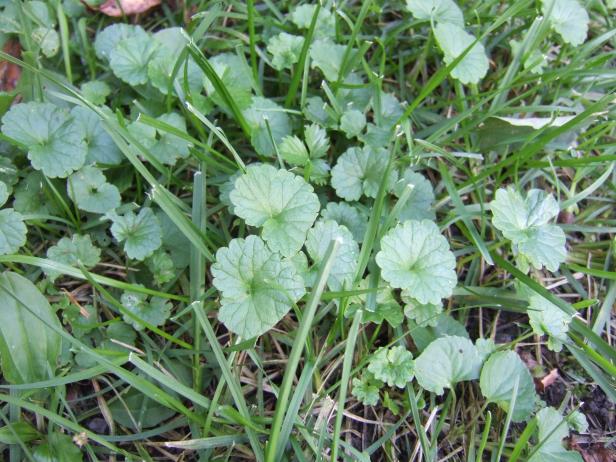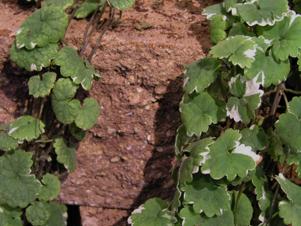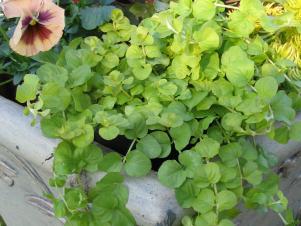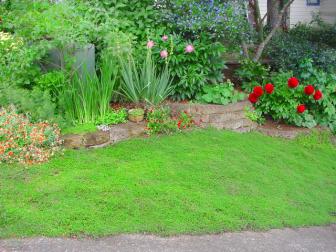How to Get Rid of Creeping Charlie
This shade-loving groundcover grows fast — so fast it can take over your yard and become a plant nuisance. Here's how to banish creeping Charlie when it grows in the wrong place.

Julie Martens Forney
In part to full shade lawns, creeping Charlie can quickly become a severe problem. Stems root where they touch soil, and underground stems move through soil to establish new plants.

Creeping Charlie, also known as ground ivy, is a shade-loving perennial that’s grown as groundcover. It’s also sometimes used in containers and hanging baskets because it’s easy to grow and looks lovely trailing over the sides of the pot. But once it escapes the place it’s planted —and it always escapes, thanks to its prolific seeds, rhizomes and stems that grow roots — creeping Charlie becomes an aggressive, invasive plant that will take over your lawn and garden. Read on to learn how to get rid of creeping Charlie when it becomes a problem.
Botanical Name: Glechoma hederacea
Common Name: Creeping Charlie, ground ivy, gill-over-the-ground, alehoffs, cat’s foot
Plant Type: Herbaceous perennial
Hardiness Zones: 2 to 12
Identifying Creeping Charlie
Several types of plants get called creeping Charlie, including Swedish ivy and Lysimachia nummularia (aka Creeping Jenny or moneywort,) but the nuisance plant we’re talking about is Glechoma hederacea. Creeping Jenny looks a lot like creeping Charlie, but Jenny doesn’t have scalloped leaves.
Creeping Charlie

Creeping Jenny

Creeping Charlie is a cousin to mint, so it has a strong, minty odor when you crush it. Charlie’s leaves are bright green, round or kidney-shaped, and have scalloped edges; its stems grow into thick, carpet-like mats. A variegated version has pale green leaves tipped in white. Charlie’s a perennial, so it comes back every year, like it or not. In the spring it produces small, funnel-shaped blue flowers.
Like many invasive plants, creeping Charlie was brought to North America by Europeans who thought it would make a great groundcover for shady places where little else would grow. And grow it did. A few centuries later, many states officially listed creeping Charlie as an invasive weed. Connecticut has even banned it. Creeping Charlie isn’t vulnerable to any pests and diseases. Heck, goats won’t even eat it because a bellyful of the stuff will make them sick. Here’s how to kill creeping Charlie.
How to Remove Creeping Charlie by Hand
If the creeping Charlie you'd like to kill is near edible plants, or if children or pets play nearby, don't spray it with industrially produced herbicides or weed killer. You can pull Charlie out, by hand, no chemicals needed. Yes, you can do this. You’ll just need time, muscle and a commitment to gardening sustainably. Here’s how:
- Trim the leaves and stems from creeping Charlie so you can see where the stems emerge from the ground. Bag up the trimmings and either throw them in your compost pile IF you know your compost gets hot enough to kill weed seeds, or throw them in a trash can. Don’t just leave them on the ground; if you do, they’ll grow roots from the stems and establish a whole new patch of Charlie. We told you this stuff was hard to kill.
- Soak the soil. Use your garden hose to saturate the soil around the creeping Charlie. Give the water an hour to soak into the ground. You want the water to loosen the roots’ grip on the soil so it’s easier for you to pull the roots out without breaking them off in the ground. Alternatively, wait for a rainstorm to soak the ground for you naturally.
- Loosen the soil with a pitchfork. Gently lift up forkfuls of soil to expose the roots and rhizomes of Charlie.
- Pull up the plants. Hold on to each Charlie plant at its base and pull it out of the dirt, slowly but firmly, being sure to remove the roots with the plant. For deep roots, use the pitchfork to loosen the soil farther down so you get the plant and roots in one pull. Put the whole plant, roots and all, in that bag with the trimmings. Remember, each time you bend down to pull a weed out by the roots, it’s just like doing a squat in the gym. You’re getting fit and the creeping Charlie is getting dead. Strong legs, and a weed-free and herbicide-free yard. It’s a win-win.
- Look for pieces of plant and roots you missed. Use a trowel or weeding fork and poke around in the soil to seek out remaining roots or plants. If you leave a scrap of Charlie’s roots or stems in the area, they’ll grow into a new plant.
- Repeat in a few weeks. No matter how thorough you are, you’re going to miss some roots. Keep an eye on the area, and pull up new creeping Charlie plants by the roots as soon as you see them. Lather, rinse, repeat. Hand-pulling weeds is eco-friendly, but slow. It’s going to take a couple of passes to eradicate creeping Charlie from the spot.
How to Kill Creeping Charlie With Herbicides
If your patch of creeping Charlie is too big to pull out by hand in this lifetime, you may have to resort to a chemical weed killer. Unless you want to kill every plant in the area, spray just the creeping Charlie with a lawn-friendly product, like a broadleaf herbicide. Follow manufacturer’s instructions, but here are some tips on how to kill creeping Charlie:
- The best time to spray weed killer on Charlie is in the fall after the first frost.
- Pick a day with no wind so the weed killer doesn’t blow onto plants you want.
- Make sure it’s not going to rain or snow within 24 hours after you spray.
- After you’ve sprayed the area, leave it alone for the winter. The creeping Charlie will die, and its roots will compost into the soil.
- In the spring, rake up any dead plant debris, amend the soil and plant something you like.
How to Kill Creeping Charlie Without Chemicals
Creeping Charlie is particularly persistent and not easily deterred by natural solutions such as smothering with cardboard or spraying with natural weed killer made using vinegar.
Borax, a naturally occurring mineral used in laundry, is sometimes recommended for a natural application; experts at the University of Iowa provide a recipe for this method, but caution that it may not be as effective as broadleaf herbicide and, while natural, can also harm neighboring plants.
The lesson: Whatever you use, apply properly and target the weed itself, not surrounding areas.
How to Stop Creeping Charlie From Coming Back
Weeds grow in the conditions they like, and in the case of creeping Charlie, that's shady spots and wet, nutrient-poor soil. Help your lawn out-compete weeds by giving it the conditions it needs — fertile, well-draining soil and sunlight. And keep this creep out of garden beds by maintaing them with mulch.
12 Year-Round Lawn Care Tips 15 Photos
No matter what time of the year you’re growing grass, brush up on your lawn care routine with these quick and easy tips.
Maybe Creeping Charlie’s Not All Bad?
OK, even a creep like Charlie has some benefits. If you can keep it under control, creeping Charlie has powers that can be harnessed for good.
18 Tough Groundcovers 18 Photos
Tired of mowing that lawn? Why not replace expensive, high-maintenance sod with an easy-care, environmentally-friendly groundcover?
It’s edible. Ask a wild-food forager and they’ll tell you Charlie’s young leaves have a mild mint flavor and are delicious tossed into salads. Leaves can also be cooked like spinach, or added to soups or omelettes. You can also make a tea from creeping Charlie leaves. As with any foraging, be sure that plants have not been sprayed with chemicals before eating.
It’s a lawn substitute. If you’re looking for an eco-friendly, low-maintenance alternative to turf grass in a shady area, creeping Charlie is an option. It grows in thick mats you won’t need to mow. There are noninvasive groundcovers that are better choices for turf substitute, though.
It’s good for erosion control. Creeping Charlie grows in shady conditions and in poor soil, so if you have an area prone to washout, creeping Charlie can keep the soil in its place.
Pollinators like it. Creeping Charlie’s flowers produce nectar in the spring and early summer that's loved by bees and butterflies. Your weed is their food.






































